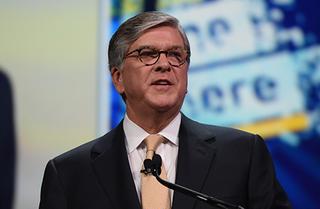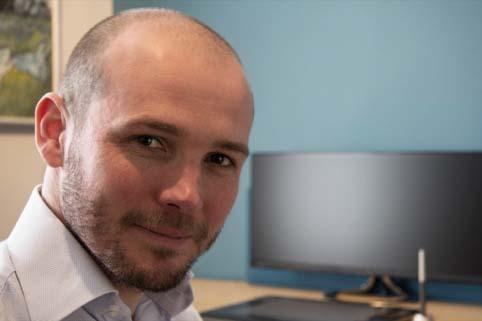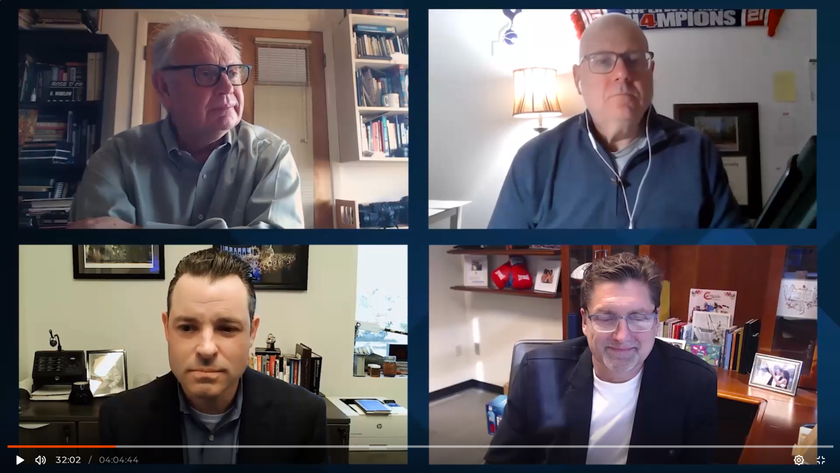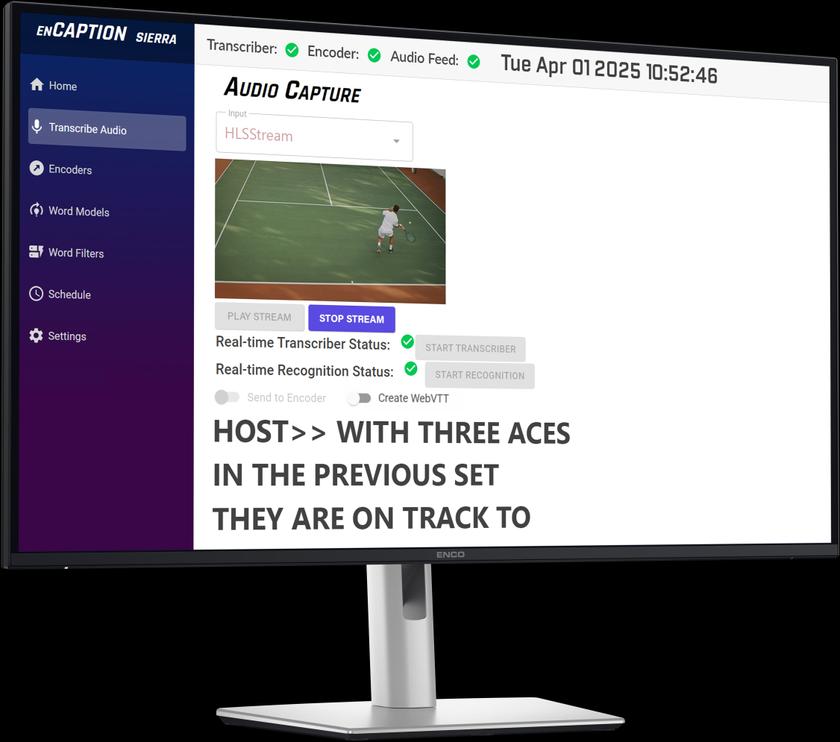Smith Lauds Broadcasters' Principles at NAB Show Keynote
LAS VEGAS—National Association of Broadcasters President and CEO Gordon Smith gave his annual opening keynote at the 2017 NAB Show on Monday, preceded by a live streamed message from the International Space Station, where he talked about the changes, choices and principles that are defining the broadcast industry. Here is the full transcript of Smith's speech:

Thanks again to our friends in NASA and astronaut Peggy Whitson for that special message.
Back here on Earth at the NAB Show, we are witnessing the thrilling innovations taking place in 4K UHD and Next Generation Television, along with new technologies bringing radio to every device.
Indeed, the story of broadcasting is one rooted in innovation, inspiration and imagination.
From Orson Welles’ 1938 War of the Worlds radio broadcast to the live television broadcast of man’s first steps on the Moon, to the fall of the Berlin Wall and the tragedy of 9/11, America’s broadcasters have brought us the indelible moments that have touched our lives.
No doubt, the world has changed since the very first radio and TV broadcasts.
In fact, the media landscape seems to be changing at the blink of an eye, along with the world at large.
And, these changes can seem both unsettling and exciting.
Change is a fact of life... except if you’re like comedian Steven Wright who once noted, “Change is inevitable, except from vending machines.”
Or, the late George Carlin who said, “I put a dollar in a change machine. Nothing changed.”
When we talk about broadcasting, it’s very easy to talk about change – both in the way consumers access content and the way broadcasters are delivering it.
But there are some things technology will never change: Listeners and viewers will always want that local connection that broadcasters provide – with the weatherman who tells them if a storm is approaching, or with their favorite DJ who warns them of the traffic building up ahead.
The highest-quality content will always find its way to broadcast TV because of its unparalleled reach.
Even in this era of unprecedented competition for eyeballs, broadcast TV airs 90 of the top 100 most-watched television shows every week.
And 268 million people tune into broadcast radio every week to discover new music and artists.
Communities know their local broadcasters will always offer a lifeline in times of crisis, when it matters most.
And, the public will always depend on broadcasters to be the bedrock of our democracy to fiercely defend our First Amendment rights, and relentlessly pursue and report the facts without fear or favor.
No... technology hasn’t changed our commitment to serving our communities.
What has changed is the way we deliver our highly-valued content and services.
We are discovering these exciting changes right here at the NAB Show, which was recently recognized in the list of top 10 trade shows in the world.
Kudos to Chris Brown and his entire Conventions and Business Operations team for this achievement.
A whole new generation of content creators and distributors are experiencing The Met effect at this event.
From mixed reality, to autonomous cars and the future of cinema, we are witnessing the convergence of media, entertainment and technology that is enriching all of our lives.
Broadcasters have been at the core of this ever-changing landscape, bringing together all of these dynamic partners to deliver content consumers seek anytime, anywhere.
As my late friend, former professor and author of the “7 Habits of Highly Effective People,” Stephen Covey, said, there are three constants in life – change, choice and principles.
The same could be said for broadcasters.
We face change.
We have choices to make.
But we must always be guided by our principles.
Let’s begin with change.
Our world is, at the same time, both more connected than ever and more untethered than ever.
People can access virtually anything from virtually anywhere – and there are millions of sources of information.
In addition to radio and TV station broadcasts, Americans also get the information they need from stations’ websites, digital apps and social media pages.
The way people access broadcast content is changing rapidly, as we’ve seen with over-the-top, streaming and NextRadio.
Many of the challenges and opportunities our industry faces are being driven by new technologies, and primarily the rise of internet protocol – or IP – distribution in its many forms.
All of these things are rapidly changing our business.
This leads us to choices.
What do we do in this ever-changing world?
We need to believe in the virtuous cycle – the idea that adopting new distribution platforms serves to build our overall audience and engagement with them.
And with our core service, we need to embrace our strengths: We are live, local and targeted.
We are the most trusted source for news and information for those events that shape the world and our communities.
We have a one-to-many architecture that is the envy of other media platforms.
In fact, TV stations turned down $38 billion during the recent spectrum incentive auction, choosing to keep their channels, compared to speculators and wireless companies that paid $19 billion for a portion of the TV band.
I think we now know what the highest and best use of spectrum is.
When we take our strengths and combine them with new technologies like IP distribution and greater connectivity, broadcasters can leverage the combination to make us even stronger.
This brings us to the very exciting development of Next Gen TV.
This is the world’s first broadcast standard that offers the advantages of broadcast and broadband.
Through Next Gen TV, broadcasters can deliver the benefits of ultra high definition TV to viewers, as well as interactive features and customizable content.
Viewers can also look forward to more choices, more channels and more flexibility, along with improved reception and building penetration.
Perhaps Next Gen TV’s biggest promise is to revolutionize how we stay connected in times of emergency with devices that can “wake up” to warn viewers, and public warnings that are geo targeted with rich media, interactivity and mobile.
With Next Gen TV, we see the seamless convergence of over-the-air and over-the-top.
In other words, increasing the efficiency and value of our remaining spectrum.
We are pleased that the FCC is carefully considering our request that broadcasters be permitted to voluntarily adopt Next Gen TV – just as the wireless industry is permitted to move from 3G to 4G to 5G, as technology improves.
FCC Chairman Ajit Pai has said he hopes the Commission can issue a final authorization of the standard later this year.
Meanwhile, NAB continues to lead the effort to educate U.S. policymakers about the great benefits to viewers in expediting the approval of Next Gen TV.
The best place to see what’s possible is right here at NAB Show at the Next Gen TV Hub: Powered by ATSC 3.0 in the Grand Lobby of the Convention Center.
And while there are a lot of exciting developments in television technology, radio’s future also lies in being available on every device and making choices that support its innovations.
Broadcasters have worked tirelessly to promote access to radio receivers in smartphones.
Virtually all smartphones are manufactured with hardware capable of receiving free FM radio signals, but not all phones have this feature activated, either by choice of the phone’s manufacturer or the wireless carrier.
We applaud the major U.S. carriers – Sprint, AT&T, T Mobile and Verizon – for unlocking FM capability in their Android phones.
NAB is also urging Apple to provide its customers with this feature, but they have not done so yet.
The former head of the Federal Emergency Management Agency, Craig Fugate has said activating FM radio in smartphones would “ensure if all else fails, you can still get information from the broadcasters” during times of emergency.
We hope our friends at Apple are listening and will soon make this potentially lifesaving technology available to their customers.
Additionally, many radio stations are broadcasting in digital using HD Radio and streaming online.
We are also ensuring radio continues to evolve to retain its rightful place in the automotive dashboard of the future.
Radio continues to be the dominant choice for audio entertainment, despite the proliferation of numerous streaming options.
We will leverage this strength to continue offering the interactive experience that radio listeners desire wherever they may be.
We are seeking to create new and engaging experiences for radio, working with Ford and General Motors, among others, on various software development projects for radio in the connected car.
We look forward to hearing from one of Ford’s top executives on the future of radio in the car at tomorrow’s Radio Luncheon.
Because all innovation begins with an idea, we launched the PILOT Innovation Challenge last year to encourage and gather the best ideas for broadcasters to better serve their communities.
It was a huge success with over 150 entries.
This year, we are delighted to grow this competition with the support of a $200,000 grant from the Knight Foundation.
It goes without saying, but let me say it anyway: Broadcasting is a great business, and this an exciting time as new technologies are giving us the ability to improve the delivery of our content.
And that brings us to the third and final “constant” according to Stephen Covey… our principles.
The choices broadcasters make as we innovate through new technologies must be based on our core principles –
…Providing a lifeline during emergencies and keeping our communities safe…
…Raising awareness of important health and social issues that impact our lives…
…Providing good jobs and essential information that come from advertising and contribute to our local and national economies…
…And, defending our democratic ideals, the right to speak freely without fear of incrimination, and the right of the press to challenge the government and root out corruption in high places, public or private.
Thomas Jefferson once said: “In matters of style, swim with the current; in matters of principle, stand like a rock.”
When it comes to defending our core principles, broadcasters are standing as a rock.
Broadcasters carry the torch of freedom and integrity, and we must use this to question those in power, to expose those who abuse their positions and to find the truth.
Whether it’s the people in charge of our government, or innovations that are changing the way consumers access their content, change is a constant for us.
John F. Kennedy said, “Change is the law of life. And those who look only to the past or present are certain to miss the future.”
I invite you to join me as we continue to embrace this law of life… and all the future opportunity that comes with it.
Get the TV Tech Newsletter
The professional video industry's #1 source for news, trends and product and tech information. Sign up below.













